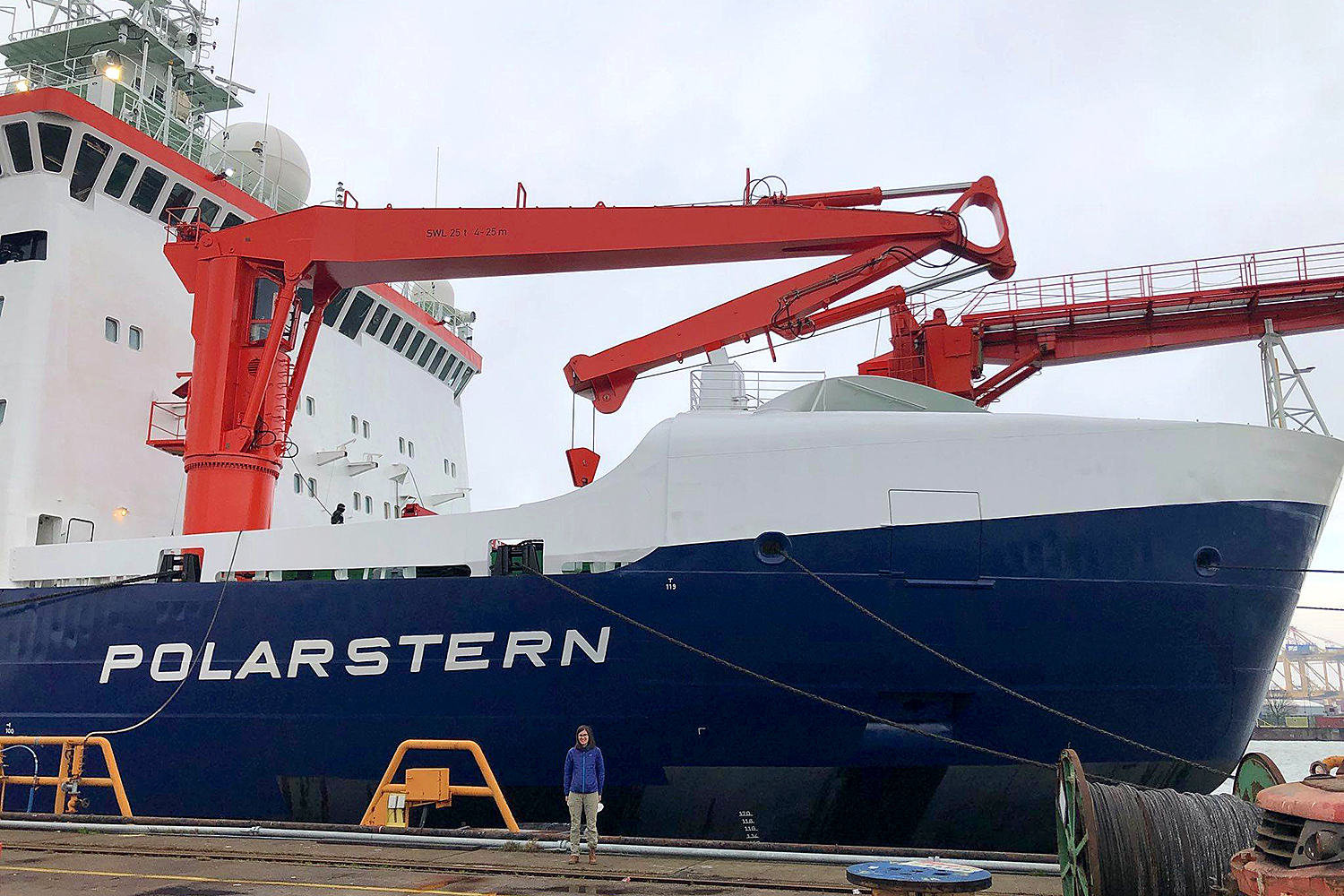The Mercury Secret in the Deep Sea TU Braunschweig scientist on Polarstern expedition
The boxes have long been packed, all the permits have been obtained and the medical check has also been completed: Now Dr Marta Pérez Rodríguez from Technische Universität Braunschweig is on board the research vessel “Polarstern”. The icebreaker of the Alfred Wegener Institute (AWI) has set off from Cape Town on 2 October for the South Atlantic. There, as part of the Island Impact expedition, the environmental scientist will collect water and sediment samples in the waters around South Georgia. The aim is to find out where the mercury sediments in the depths of the sea.

In Bremerhaven, Dr Marta Pérez Rodríguez was already able to take a look at the research vessel. Now she is setting off with the “Polarstern” from Cape Town towards the South Atlantic. Photo credit: Marta Pérez Rodríguez/TU Braunschweig
From October to December, the two-part expedition “Island Impact” is investigating biogeochemical substance flows around South Georgia, a group of islands in the South Atlantic east of the east coast of South America. Some of the highest concentrations of phytoplankton in the Southern Ocean occur here. These substantial algal blooms require a source of iron for their development. The main focus of the expedition is to understand the sources and pathways of iron and other nutrient inputs into the shelf waters of South Georgia and further downstream into the Southern Antarctic Circumpolar Current (ACC).
Mercury enclosed in sediments
This is also where the research of the Environmental Geochemistry group at the Institute of Geoecology comes in, which focuses on the trace metal mercury. Mercury is a highly toxic pollutant that can cause severe harm to human health. Most mercury pollution enters the atmosphere from the burning of coal and other fossil fuels, as well as from industrial activities. But where does it then go?
Professor Harald Biester and Dr Marta Pérez Rodríguez have been researching mercury cycling and primary productivity in the oceans since as early as 2016. In a study published in the journal “Science” in 2018, which received international recognition, they found that the Antarctic silica sediments studied contained surprisingly large amounts of mercury. The results suggest that up to 25 per cent of mercury emissions over the last 150 years may be trapped in such sediments. “From the research cruise with the ‘Polarstern’ we now hope to gain further insights into mercury cycling, the fate of mercury in the water column in productive marine areas and the role of algae blooms for the sequestration of mercury in marine sediments,” says Professor Biester.
Samples from a depth of 6,000 metres
Among other things, the scientists will take water samples at depths of up to 5,000 metres and deep ocean sediments at depths of more than 6,000 metres. “The expedition provides us with the means to collect a variability of samples that would otherwise not be possible.,” says Dr Marta Pérez Rodríguez. For example, the researchers are using special water pumps to collect suspended matter in the depths, which is not standard equipment in many marine studies. “We will combine the obtained data with basic seawater characteristics such as density, salinity, temperature, oxygen concentration, and chlorophyll concentration, as well as with information provided by other groups, for example identification of zooplankton species and other trace metal concentrations.”
The scientist spent months preparing for the expedition. In addition to training for the work on board, permits for sampling had to be obtained and, above all, the working material had to be cleaned several times. “The mercury concentrations in the open ocean are very low, so we have to work in very clean conditions,” explains Dr Marta Pérez Rodríguez. “As an example, the cleaning of the bottles we will use to collect methyl-mercury takes approximately twelve days and includes several steps with soaps, concentrated acids and ultra-pure water.”
Well equipped against stormy seas
In addition, a medical check was scheduled for all participants. Life and research on board could get uncomfortable for the environmental scientist from time to time. Even though the “Polarstern” is expected to start in Cape Town in rather spring-like weather, it will not stay that way during the expedition. The further south the research vessel moves, the lower the temperatures will become. And near South Georgia, storms with high waves could affect the work. The expedition members are well equipped against the cold: The AWI provides extra clothing with waterproof trousers and jacket, fleece jacket, woollen cap, gloves and safety boots.
The fact that the expedition might be a bit stormy does not scare Dr Marta Pérez Rodríguez. She is happy that it is finally getting underway: “To be part of an expedition on board an oceanographic ship like the Polarstern and in a place like the South Atlantic is a milestone in my career and my life. Personally, because it fulfils the dream of my youth as a student of environmental sciences to participate in a big scientific expedition.”
Publication
Sara Zaferani, Marta Pérez-Rodríguez, Harald Biester: Diatom ooze – A large marine mercury sink. Science, Vol. 361, NO. 640424 Aug 2018: 797-800,
DOI: https://doi.org/10.1126/science.aat2735
More information:
Interview with Dr. Marta Pérez-Rodríguez: “Setting off on a stormy research trip”
